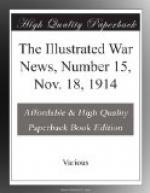_______________________________________________________
___________________ 16—The illustrated war news, Nov. 18, 1914.
[Illustration: Not even the dead left in Peace! German shells unearth graves and scatter their contents in A village churchyard.]
In our last issue we gave a photograph of a Galician town bombarded by the Russians, proving that they carefully avoid the destruction of churches. The German gunners, on the contrary, show no respect for the House of God, although their Emperor so often claims Divine approval. The havoc wrought by German shells in French and Belgian churches and cathedrals stands recorded in countless photographs and other illustrations, to form a permanent Indictment of Germany’s methods of warfare that will make her name execrated by posterity. In the present instance not only the church itself was destroyed, but the very graves were torn open, and the bodies and bones of the desecrated dead flung from their places of rest—[Facsimile Drawing by H.C. Seppings Weight Special War Artist.]
_______________________________________________________
___________________ The illustrated war news, Nov. 18, 1914—17
[Illustration: A German saw-edge bayonet in actual use in the war: When the German Flag was planted on A captured position.]
It has been pointed out by a Naval correspondent that the German bayonet of which one edge is a saw is not really quite the barbarous weapon it seems, but is similiar to that carried by pioneers in British naval landing-parties, for use in sawing wood. The toothed edge, he mentions, is so far from the point that only by the rarest chance could it enter the body of an enemy. It would be interesting to know whether the two bayonets British and German—are exactly similar. Another account of the German weapon states that the saw-edge begins only six inches from the point, quite near enough thereto, one would imagine, to “enter the body of an enemy.” Inset is an enlargement of the German saw-bayonet—[Photo. by L.N.A.]
_______________________________________________________
___________________ 18—The illustrated war news, Nov. 18, 1914.
[Illustration: Where French sailors fought at Dixmude: Naval-brigade defences.]




